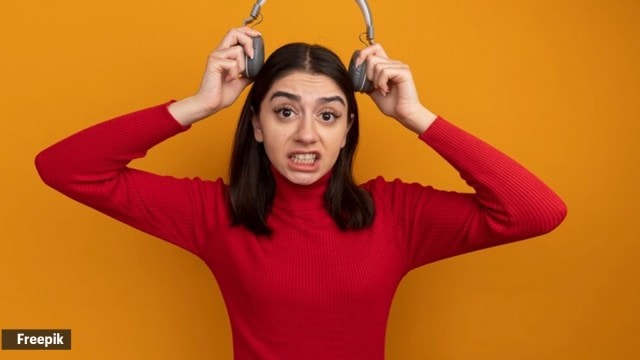📣 For more lifestyle news, click here to join our WhatsApp Channel and also follow us on Instagram
Understanding the 60:60 rule and its effectiveness against hearing loss
Did you know that prolonged exposure to loud music can permanently damage your ears? Here’s why you need to start following the 60%/60-minute rule
 Keeping the harmful effects of prolonged exposure in mind, experts have come up with the 60%/60-minute rule or the 60:60 rule. (Source: Freepik)
Keeping the harmful effects of prolonged exposure in mind, experts have come up with the 60%/60-minute rule or the 60:60 rule. (Source: Freepik)Have you been listening to your music too loudly? Does your iPhone regularly alert you to turn the volume down? If that’s the case, then you need to pay attention and keep the volume under check.
According to the Centers for Disease Control and Prevention (CDC), listening to loud sounds over a long period can cause hearing loss. Listening to loud noise for a long time can overwork hair cells in the ear, it adds, which can cause these cells to die.
As one continues to listen to loud music, the hearing loss progresses. Not only that, the harmful effects may continue even after exposure to loud sounds has stopped. “Damage to the inner ear or auditory neural system is generally permanent,” the CDC warns.
Keeping the harmful effects of prolonged exposure in mind, experts have come up with the 60%/60-minute rule or the 60:60 rule. This rule recommends listening to music or sounds at 60 percent of the maximum volume for no more than 60 minutes a day. Dr Manoj Mishra, senior consultant ENT, head, neck, and cancer surgeon at Max Super Speciality Hospital, Lucknow, says that there are several consequences to long-term exposure to high volume levels.
 According to the Centers for Disease Control and Prevention (CDC), listening to loud sounds over a long period of time can cause hearing loss. (Source: Freepik)
According to the Centers for Disease Control and Prevention (CDC), listening to loud sounds over a long period of time can cause hearing loss. (Source: Freepik)
“Prolonged exposure to high-volume levels through personal listening devices can significantly increase the risk of noise-induced hearing loss (NIHL). This type of hearing loss occurs when loud sounds damage the hair cells in the inner ear, which are critical for converting sound waves into electrical signals for the brain to interpret,” he explains.
Besides hearing loss, he adds, other potential long-term effects include tinnitus (ringing in the ears) and hyperacusis (increased sensitivity to certain frequencies of sound). Hearing loss from loud sound exposure is cumulative and irreversible, highlighting the importance of preventive measures to protect hearing health.
Impact of the “60:60 rule” on an individual’s risk of developing noise-induced hearing loss
The ‘60:60 rule’ suggests listening to music or audio at no more than 60% of the device’s maximum volume for no more than 60 minutes at a time. This guideline aims to reduce the risk of NIHL by limiting both the intensity and duration of sound exposure.
Adherence to this rule, Dr Mishra discloses, can significantly mitigate the risk of damaging the hair cells in the inner ear, as it keeps sound exposure within safer levels. The physiological mechanism is straightforward: lower volumes and shorter listening periods reduce the overall energy impact on the ear’s delicate structures, decreasing the likelihood of injury.
Effectiveness of features such as ‘smart volume’ in regulating safe listening habits
Dr Mishra agrees that many modern personal listening devices come equipped with ‘smart volume’ features, which either warn the user when the volume exceeds safe listening levels or automatically adjust the volume. “These features can be effective tools in promoting safe listening habits,” he says.
He also recommends that to optimise these features, users should familiarise themselves with their device’s audio settings, enable any available volume warnings, and consider using volume limit controls if available. Regularly updating the device’s software ensures that users benefit from the latest enhancements in safety features.
Common misconceptions about listening to loud sounds and recommendations healthcare professionals for promoting safe-listening practices
“One common misconception is that if other people cannot hear your music, it’s not too loud for your ears. However, earbuds or headphones can direct sound straight into the ear canal, concentrating the sound’s energy and potentially causing damage even at levels that might not be considered loud to an external observer,” explains Dr Mishra.
Many individuals find it challenging to keep track of their listening duration, he adds, or may forget to lower their volume. Furthermore, the desire for immersive listening experiences can lead individuals to listen at unsafe volumes.
“Healthcare professionals can play a critical role by educating patients about the risks of loud music exposure, demonstrating how to use personal listening devices safely, and providing hearing screenings as part of routine health check-ups,” he adds. Encouraging the use of noise-cancelling headphones can also help, Dr Mishra states, as they reduce the need to raise the volume to overcome background noise.
📣 For more lifestyle news, click here to join our WhatsApp Channel and also follow us on Instagram
- 01
- 02
- 03
- 04
- 05



























